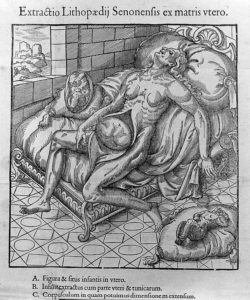By Helen King (Regular Contributor)
When Colombe Chatry, a tailor’s wife, died in May 1582 at the age of 68, at her husband’s request her body was opened up to discover what had happened to a pregnancy she had started 28 years earlier, which had never come to anything but had left her with years of abdominal pain and loss of appetite. A petrified female fetus was discovered, and was first described by one of those who saw it immediately after its discovery, the physician Albosius (Jean d’Ailleboust), in the Portentosum Lithopaedion of 1582. This work was soon after translated into French by Siméon de Provanchères.
This is one of the very strange but real things which can happen in the female body; in 2015 a story of a calcified fetus made the news, but in that case the woman carrying it was 90 – and alive. In the sixteenth century, how was this rare event understood?
Illustrations of the lithopedion sometimes included a Latin epigram linking it to the ancient Greek myth of the flood, in which the two survivors, Deucalion and Pyrrha, repopulated the world by walking over the earth and throwing stones behind them, which were transformed into living beings. This epigram may be translated as: ‘Deucalion cast stones behind him and thus fashioned our tender race from the hard marble. How comes it that nowadays, by a reversal of things, the tender body of a little babe has limbs more akin to stone?’ While the stones thrown by Deucalion softened to become mortal, the lithopedion had hardened from flesh to stone; contemporary medical writers explained this by suggesting that the cause of the phenomenon was the coldness of the womb.
Display and disappearance
What happened to this prodigy? The lithopedion of Sens was very famous, discussed extensively in its own day, and included in the literature of the monstrous thereafter. The stone fetus was exhibited in several cities of Europe – the midwife Louise Bourgeois, for example, saw it before 1636 in Paris where it was in the possession of a merchant, M. Pretesegle. At this stage, she noted that it was missing one hand, which had remained stuck to the placenta.
In 1653 the lithopedion was in Italy, from where it passed to the cabinet of curiosities of King Frederick III of Denmark, and remained there until its disappearance from the Danish Museum of Natural History some time after 1826. Does anyone know what has become of it?
From curiosity to author
I became interested in the lithopedion when I was studying the eighteenth-century man-midwife, William Smellie. In the first, 1751, edition of his Theory and Practice of Midwifery, Smellie listed the title of the image in a compendium of gynecological writings edited by Israel Spach – Lithopedus Senonensis – as an author. Oops. His rival John Burton pounced on the error, gleefully announcing that, despite six years of preparing the book, Smellie had managed to convert ‘an inanimate, petrefied Substance, into an Author’. Probably all of you who have ever written anything will be able to recall the sinking feeling when you realize you’ve made an slip like this.
The error (quickly corrected for the 1752 edition) and Burton’s attack on Smellie were sufficiently well known to form the basis of a passage in Laurence Sterne’s novel Tristram Shandy, which appeared in installments between 1759 and 1767. In volume 2, chapter 19, Sterne described how Tristram’s father, ‘who dipp’d into all kinds of books’, looked into ‘Lithopædus Senonesis de Partu difficili, published by Adrianus Smelvgot’ – clearly meant to be Smellie. The footnote states ‘The author is here twice mistaken; – for Lithopædus should be wrote thus, Lithopædii Senonensis Icon. The second mistake is, that this Lithopædus is not an author, but a drawing of a petrified child. The account of this, published by Albosius, 1580, may be seen at the end of Cordæus‘s works in Spachius. Mr. Tristram Shandy has been led into this error, either from seeing Lithopædus’s name of late in a catalogue of learned writers in Dr. —- , or by mistaking Lithopædus for Trinecavellius, – from the too great similitude of the names’. Ouch!
Helen King is Professor of Classical Studies at The Open University. Her most recent book is The One-Sex Body on Trial (2013). She’s recently been devoting most of her time to creating a free online course on Health and Wellbeing in the Ancient World, which runs for six weeks from 6 February 2017. She also tweets as @fluff35, and has a personal blog on which she comments on various aspects of academic life.
The post Stone Babies: The Lithopedion of Sens appeared first on Wonders & Marvels.

